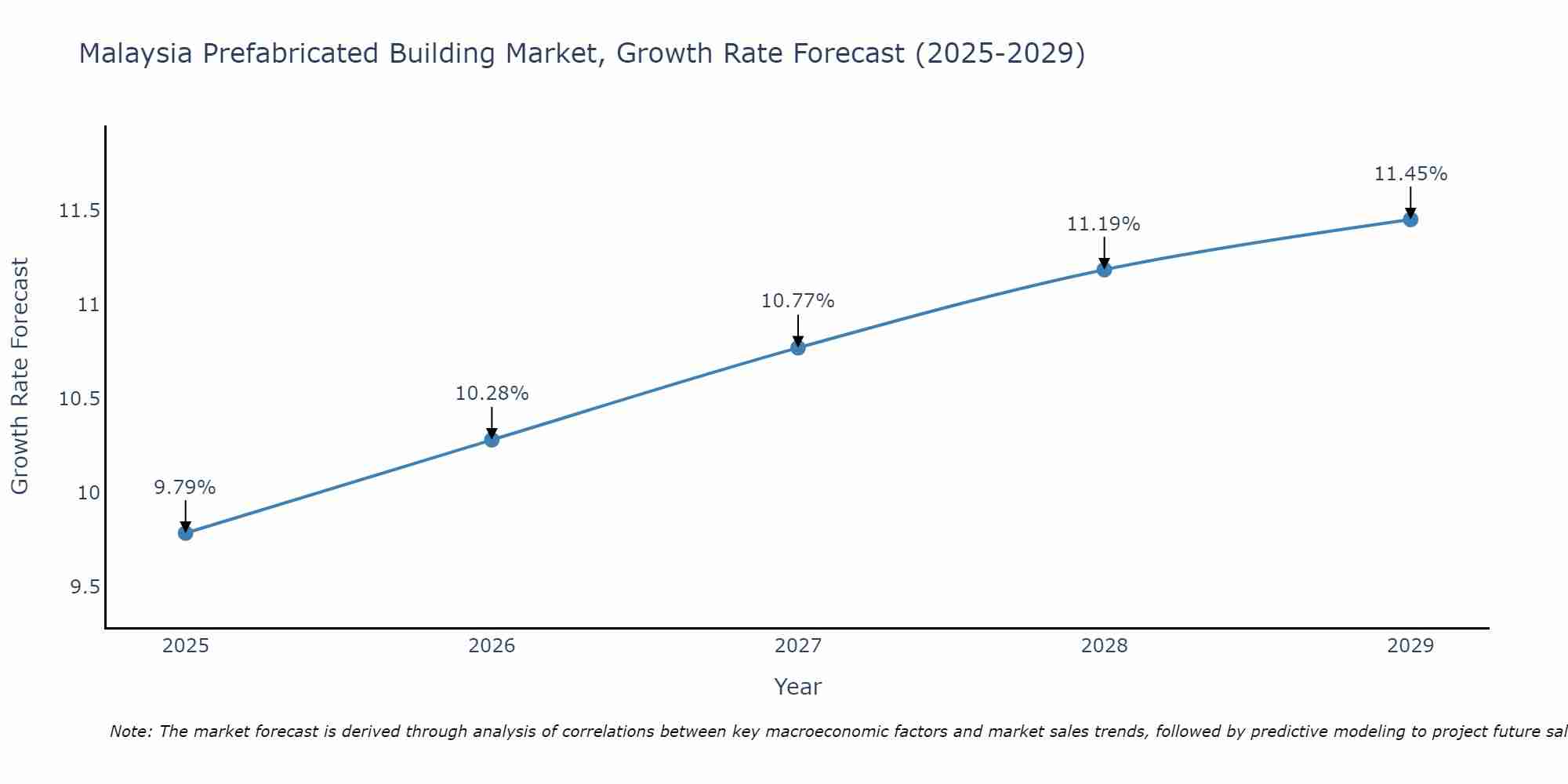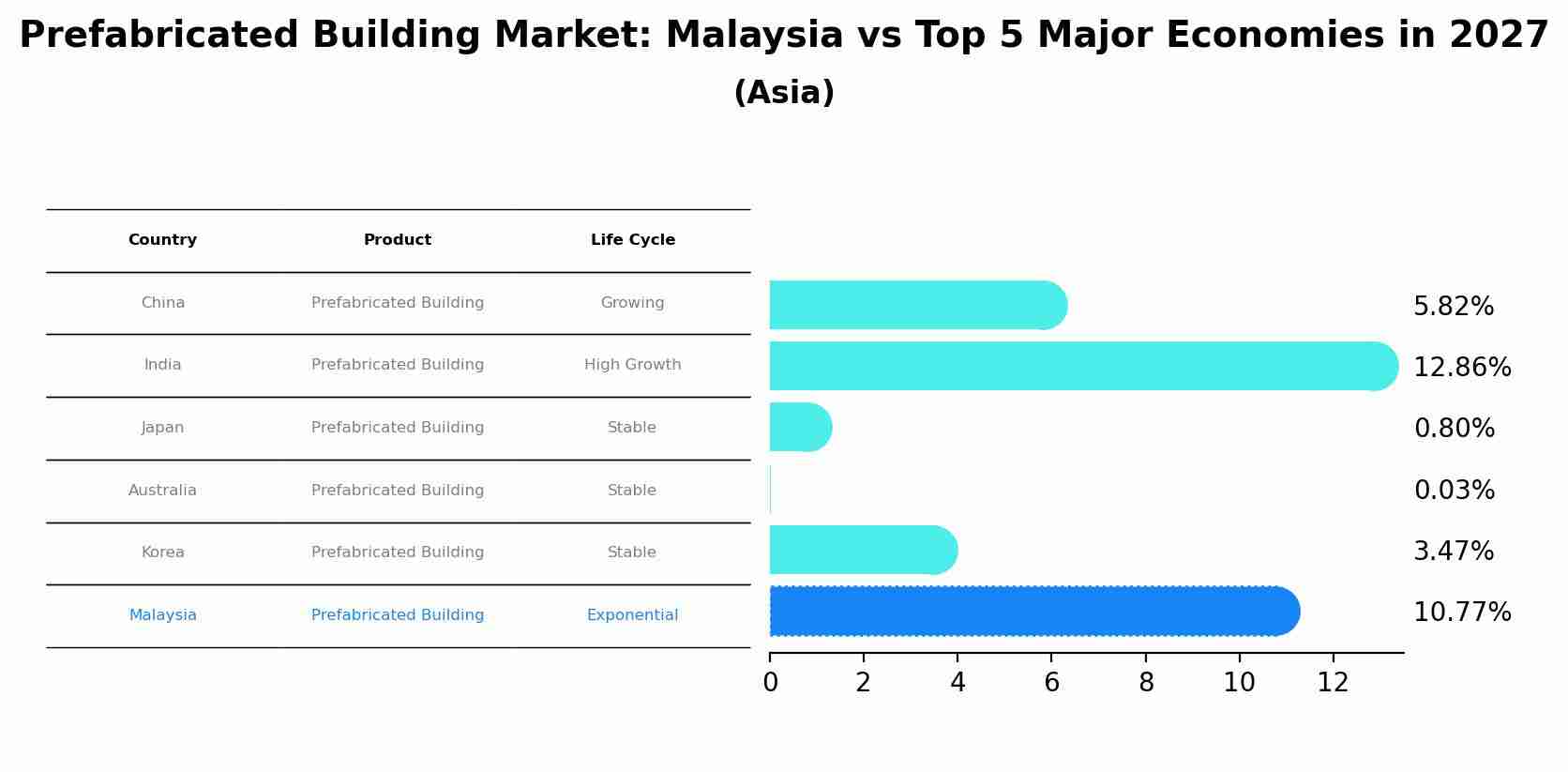Malaysia Prefabricated Building Market (2025-2031) Outlook | Companies, Value, Analysis, Share, Trends, Growth, Revenue, Industry, Size & Forecast
| Product Code: ETC275546 | Publication Date: Aug 2022 | Updated Date: Aug 2025 | Product Type: Market Research Report | |
| Publisher: 6Wresearch | Author: Ravi Bhandari | No. of Pages: 75 | No. of Figures: 35 | No. of Tables: 20 |
Malaysia Prefabricated Building Market Size Growth Rate
The Malaysia Prefabricated Building Market is poised for steady growth rate improvements from 2025 to 2029. The growth rate starts at 9.79% in 2025 and reaches 11.45% by 2029.

Prefabricated Building Market: Malaysia vs Top 5 Major Economies in 2027 (Asia)
By 2027, the Prefabricated Building market in Malaysia is anticipated to reach a growth rate of 10.77%, as part of an increasingly competitive Asia region, where China remains at the forefront, supported by India, Japan, Australia and South Korea, driving innovations and market adoption across sectors.

Malaysia Prefabricated Building Market Synopsis
The Malaysia prefabricated building market is on an upward trajectory due to the advantages of speed, cost-efficiency, and sustainability associated with prefabricated construction methods. As urbanization and infrastructure development continue, the demand for prefabricated buildings is expected to rise. Market participants should focus on offering innovative design solutions and sustainable materials to cater to the growing market.
Drivers of the Market
The Malaysia prefabricated building market is poised for growth due to several key drivers. Firstly, rapid urbanization and a growing population are leading to increased demand for affordable and quick construction solutions. Prefabricated buildings offer cost-effective and time-efficient construction methods, making them a preferred choice for developers and builders. Secondly, government initiatives to promote sustainable and energy-efficient construction practices are driving the adoption of prefabricated buildings. These buildings can be designed with energy-efficient features, reducing long-term operational costs. Lastly, the COVID-19 pandemic has underscored the importance of modular and prefabricated construction, as it allows for safer and more controlled working environments, which can mitigate the impact of future pandemics or disruptions.
Challenges of the Market
One of the key challenges in the Malaysia prefabricated building market is the need for widespread adoption and acceptance of this construction method. While prefabrication offers advantages like reduced construction time and cost efficiency, traditional construction methods remain deeply ingrained in the industry. Overcoming this resistance to change and educating stakeholders about the benefits of prefabrication will be crucial for market growth. Additionally, ensuring the quality and durability of prefabricated structures is essential to build trust among customers.
COVID 19 Impact on the Market
In the Malaysia prefabricated building market, the pandemic highlighted the importance of efficient and rapid construction methods. Prefabricated buildings offer advantages in terms of speed and cost-effectiveness, which became more apparent during the pandemic. As a result, the market for prefabricated buildings is expected to witness increased interest from both the public and private sectors. Government investments in affordable housing and infrastructure projects are likely to drive growth in this sector.
Key Players in the Market
The prefabricated building market in Malaysia is witnessing significant growth due to its cost-effectiveness and time-saving benefits. Key players in this industry include PrefabBuilders Malaysia, BuildQuick, and ModularHomes MY.
Key Highlights of the Report:
- Malaysia Prefabricated Building Market Outlook
- Market Size of Malaysia Prefabricated Building Market, 2024
- Forecast of Malaysia Prefabricated Building Market, 2031
- Historical Data and Forecast of Malaysia Prefabricated Building Revenues & Volume for the Period 2021-2031
- Malaysia Prefabricated Building Market Trend Evolution
- Malaysia Prefabricated Building Market Drivers and Challenges
- Malaysia Prefabricated Building Price Trends
- Malaysia Prefabricated Building Porter's Five Forces
- Malaysia Prefabricated Building Industry Life Cycle
- Historical Data and Forecast of Malaysia Prefabricated Building Market Revenues & Volume By Dimensions for the Period 2021-2031
- Historical Data and Forecast of Malaysia Prefabricated Building Market Revenues & Volume By Skeleton System for the Period 2021-2031
- Historical Data and Forecast of Malaysia Prefabricated Building Market Revenues & Volume By Panel System for the Period 2021-2031
- Historical Data and Forecast of Malaysia Prefabricated Building Market Revenues & Volume By Cellular System for the Period 2021-2031
- Historical Data and Forecast of Malaysia Prefabricated Building Market Revenues & Volume By Combined System for the Period 2021-2031
- Historical Data and Forecast of Malaysia Prefabricated Building Market Revenues & Volume By Application for the Period 2021-2031
- Historical Data and Forecast of Malaysia Prefabricated Building Market Revenues & Volume By Residential for the Period 2021-2031
- Historical Data and Forecast of Malaysia Prefabricated Building Market Revenues & Volume By Non-Residential for the Period 2021-2031
- Malaysia Prefabricated Building Import Export Trade Statistics
- Market Opportunity Assessment By Dimensions
- Market Opportunity Assessment By Application
- Malaysia Prefabricated Building Top Companies Market Share
- Malaysia Prefabricated Building Competitive Benchmarking By Technical and Operational Parameters
- Malaysia Prefabricated Building Company Profiles
- Malaysia Prefabricated Building Key Strategic Recommendations
Frequently Asked Questions About the Market Study (FAQs):
1 Executive Summary |
2 Introduction |
2.1 Key Highlights of the Report |
2.2 Report Description |
2.3 Market Scope & Segmentation |
2.4 Research Methodology |
2.5 Assumptions |
3 Malaysia Prefabricated Building Market Overview |
3.1 Malaysia Country Macro Economic Indicators |
3.2 Malaysia Prefabricated Building Market Revenues & Volume, 2021 & 2031F |
3.3 Malaysia Prefabricated Building Market - Industry Life Cycle |
3.4 Malaysia Prefabricated Building Market - Porter's Five Forces |
3.5 Malaysia Prefabricated Building Market Revenues & Volume Share, By Dimensions, 2021 & 2031F |
3.6 Malaysia Prefabricated Building Market Revenues & Volume Share, By Application, 2021 & 2031F |
4 Malaysia Prefabricated Building Market Dynamics |
4.1 Impact Analysis |
4.2 Market Drivers |
4.2.1 Government support and initiatives to promote prefabricated building technology in Malaysia |
4.2.2 Increasing urbanization and population growth driving demand for affordable and efficient construction solutions |
4.2.3 Growing awareness about the benefits of prefabricated buildings in terms of cost savings and reduced construction time |
4.3 Market Restraints |
4.3.1 Lack of skilled labor and expertise in prefabricated construction methods |
4.3.2 Resistance from traditional construction industry players towards adopting prefabricated building technology |
4.3.3 Initial high upfront costs associated with setting up prefabrication facilities and equipment |
5 Malaysia Prefabricated Building Market Trends |
6 Malaysia Prefabricated Building Market, By Types |
6.1 Malaysia Prefabricated Building Market, By Dimensions |
6.1.1 Overview and Analysis |
6.1.2 Malaysia Prefabricated Building Market Revenues & Volume, By Dimensions, 2021-2031F |
6.1.3 Malaysia Prefabricated Building Market Revenues & Volume, By Skeleton System, 2021-2031F |
6.1.4 Malaysia Prefabricated Building Market Revenues & Volume, By Panel System, 2021-2031F |
6.1.5 Malaysia Prefabricated Building Market Revenues & Volume, By Cellular System, 2021-2031F |
6.1.6 Malaysia Prefabricated Building Market Revenues & Volume, By Combined System, 2021-2031F |
6.2 Malaysia Prefabricated Building Market, By Application |
6.2.1 Overview and Analysis |
6.2.2 Malaysia Prefabricated Building Market Revenues & Volume, By Residential, 2021-2031F |
6.2.3 Malaysia Prefabricated Building Market Revenues & Volume, By Non-Residential, 2021-2031F |
7 Malaysia Prefabricated Building Market Import-Export Trade Statistics |
7.1 Malaysia Prefabricated Building Market Export to Major Countries |
7.2 Malaysia Prefabricated Building Market Imports from Major Countries |
8 Malaysia Prefabricated Building Market Key Performance Indicators |
8.1 Adoption rate of prefabricated building technology in the construction industry |
8.2 Number of government projects using prefabricated building solutions |
8.3 Rate of growth in the number of prefabrication facilities in Malaysia |
8.4 Percentage increase in the use of sustainable materials in prefabricated construction |
8.5 Average construction time savings achieved through prefabricated building projects |
9 Malaysia Prefabricated Building Market - Opportunity Assessment |
9.1 Malaysia Prefabricated Building Market Opportunity Assessment, By Dimensions, 2021 & 2031F |
9.2 Malaysia Prefabricated Building Market Opportunity Assessment, By Application, 2021 & 2031F |
10 Malaysia Prefabricated Building Market - Competitive Landscape |
10.1 Malaysia Prefabricated Building Market Revenue Share, By Companies, 2024 |
10.2 Malaysia Prefabricated Building Market Competitive Benchmarking, By Operating and Technical Parameters |
11 Company Profiles |
12 Recommendations |
13 Disclaimer |
- Single User License$ 1,995
- Department License$ 2,400
- Site License$ 3,120
- Global License$ 3,795
Search
Thought Leadership and Analyst Meet
Our Clients
Related Reports
- Canada Oil and Gas Market (2026-2032) | Share, Segmentation, Value, Industry, Trends, Forecast, Analysis, Size & Revenue, Growth, Competitive Landscape, Outlook, Companies
- Germany Breakfast Food Market (2026-2032) | Industry, Share, Growth, Size, Companies, Value, Analysis, Revenue, Trends, Forecast & Outlook
- Australia Briquette Market (2025-2031) | Growth, Size, Revenue, Forecast, Analysis, Trends, Value, Share, Industry & Companies
- Vietnam System Integrator Market (2025-2031) | Size, Companies, Analysis, Industry, Value, Forecast, Growth, Trends, Revenue & Share
- ASEAN and Thailand Brain Health Supplements Market (2025-2031) | Strategy, Consumer Insights, Analysis, Investment Trends, Opportunities, Growth, Size, Share, Industry, Revenue, Segments, Value, Segmentation, Supply, Forecast, Restraints, Outlook, Competition, Drivers, Trends, Demand, Pricing Analysis, Competitive, Strategic Insights, Companies, Challenges
- ASEAN Bearings Market (2025-2031) | Strategy, Consumer Insights, Analysis, Investment Trends, Opportunities, Growth, Size, Share, Industry, Revenue, Segments, Value, Segmentation, Supply, Forecast, Restraints, Outlook, Competition, Drivers, Trends, Demand, Pricing Analysis, Competitive, Strategic Insights, Companies, Challenges
- Europe Flooring Market (2025-2031) | Outlook, Share, Industry, Trends, Forecast, Companies, Revenue, Size, Analysis, Growth & Value
- Saudi Arabia Manlift Market (2025-2031) | Outlook, Size, Growth, Trends, Companies, Industry, Revenue, Value, Share, Forecast & Analysis
- Uganda Excavator, Crane, and Wheel Loaders Market (2025-2031) | Strategy, Consumer Insights, Analysis, Investment Trends, Opportunities, Growth, Size, Share, Industry, Revenue, Segments, Value, Segmentation, Supply, Forecast, Restraints, Outlook, Competition, Drivers, Trends, Demand, Pricing Analysis, Competitive, Strategic Insights, Companies, Challenges
- Rwanda Excavator, Crane, and Wheel Loaders Market (2025-2031) | Strategy, Consumer Insights, Analysis, Investment Trends, Opportunities, Growth, Size, Share, Industry, Revenue, Segments, Value, Segmentation, Supply, Forecast, Restraints, Outlook, Competition, Drivers, Trends, Demand, Pricing Analysis, Competitive, Strategic Insights, Companies, Challenges
Industry Events and Analyst Meet
Whitepaper
- Middle East & Africa Commercial Security Market Click here to view more.
- Middle East & Africa Fire Safety Systems & Equipment Market Click here to view more.
- GCC Drone Market Click here to view more.
- Middle East Lighting Fixture Market Click here to view more.
- GCC Physical & Perimeter Security Market Click here to view more.
6WResearch In News
- Doha a strategic location for EV manufacturing hub: IPA Qatar
- Demand for luxury TVs surging in the GCC, says Samsung
- Empowering Growth: The Thriving Journey of Bangladesh’s Cable Industry
- Demand for luxury TVs surging in the GCC, says Samsung
- Video call with a traditional healer? Once unthinkable, it’s now common in South Africa
- Intelligent Buildings To Smooth GCC’s Path To Net Zero


















